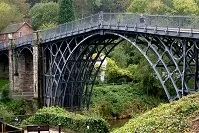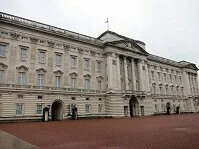
Ironbridge Gorge
There are numerous university buildings in the Gothic Revival style, including King's College (1824-1827) at Cambridge, much of Glasgow University (1866–1871), and Balliol College (1867–69) at Oxford. A few houses and castles are also in the style, including Strawberry Hill (1747) in Twickenham, Port Eliot (1804-1806) in Cornwall, Ravensworth Castle (1808) in Durham, Eastnor Castle (1810-1815) in Herefordshire, and Cardiff Castle (1865) in Wales. Finally, there are numerous religious building in the style, but some of the most impressive were original Gothic structures that were renovated in the neo-Gothic style, the most impressive of these being Lacock Abbey (1200s; renovated in the 1750s) in Wiltshire.

Buckingham Palace
Much like the Gothic style, the United Kingdom is also riddled with buildings in the neo-Classical style, which flourished in the late 1700s and the early 1800s. Again, some of these monuments are rather well known, including London's British Museum (1824-1847) and aspects of Buckingham Palace (1825–30). Scotland also became a center for the movement, most notably Edinburgh, whose New Town is almost entirely in this style. Additionally, many other buildings in the style had neo-Classical facades added to already constructed buildings and, like the neo-Gothic style, it is difficult to visit any city in the United Kingdom without seeing at least a couple neo-Classical buildings.
The final great architectural movement in the United Kingdom came with the Industrial Revolution and that revolution's gift of providing new materials and techniques for the construction of new buildings. The Industrial Revolution began in the mid-1700s in the United Kingdom so many buildings, including some of the neo-Gothic and neo-Classical buildings mentioned above were built using these new materials and constructions.

Country home
More than being used to re-construct historic styles, the movement made glass, steel, and concrete common building materials and there is no shortage of examples in the United Kingdom. This begins with the Bridge over Ironbridge Gorge (1775-1779) in Shropshire, which was the world's first cast iron bridge and the symbol of the Industrial Revolution. Other structures, which may be more symbolic of the style rather than ideal examples, include Pontcysyllte Aqueduct (1805) in Wales and the towns of Saltaire (1851) in West Yorkshire and New Lanark (thrive in the early 1800s) in South Lanarkshire.
In addition to these symbolic constructions, modern day United Kingdom has dozens of modern buildings and skyscrapers in every city, which were possible due to the Industrial Revolution. Due to the bombings in London during World War II, much of London is modern, although in many areas historic looks trumped modern design.